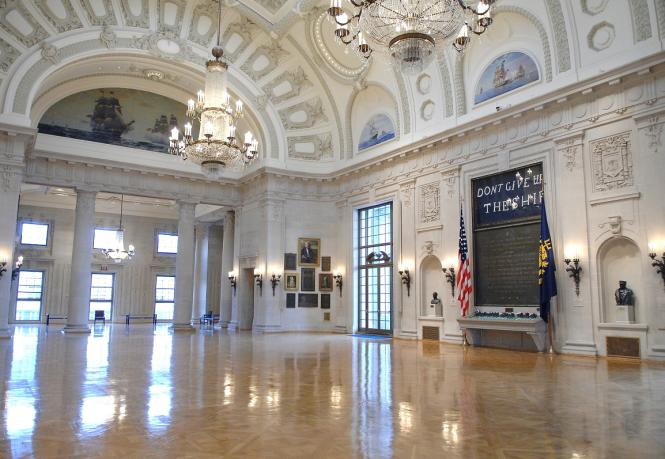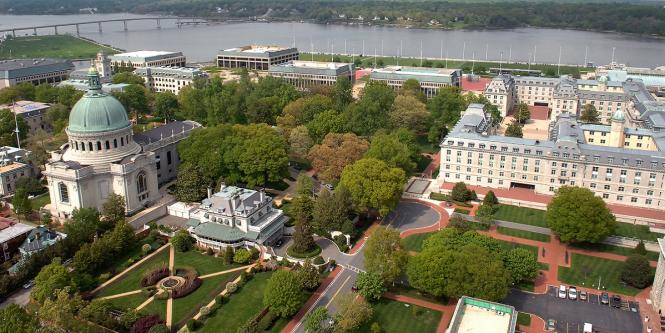The austere buildings of the U.S. Naval Academy’s campus convey the order and authority one might naturally associate with a military complex. As our Nation’s naval power continued to grow, the Yard—as USNA’s campus is known—was going direct the other way, with the 1895 annual report declaring the existing facilities as “poorly built hazards…inadequate to the future needs of the Navy.”
Ernest Flagg Goes to Annapolis
Around this same time Ernest Flagg, fresh from his studies at the École des Beaux-Arts in Paris, was a rising star with the establishment of his New York architecture firm Flagg & Chambers. He was personally engaged by Robert Means Thompson, NA 1868, to design USNA’s new buildings for “an institution that is to last for all time.”

Flagg’s time in Paris coincided with the Exposition of 1889 which featured buildings with granite towers, massive arches, symmetry, and vast amounts of interior space. This excessive formalism, popularly associated with the Beaux-Arts style, would come to define the Yard at the United States Naval Academy.
Beaux-Arts on the Banks of the Severn
The Armory, in 1903, was the first of Flagg’s buildings to be completed. Later known as Dahlgren Hall, the bare interior with exposed metal beams and imposing gates employed an intentionally utilitarian design. It also has a softer side, as the site of USNA’s annual Ring Dance and home of the thirst-quenching Drydock Restaurant.

In addition to the iconic buildings firmly standing their ground on the shores of the Severn, Ernest Flagg also laid out plans to overhaul the topography of the Yard. On the highest elevation, and facing the river, he placed the Chapel.
The serene expanse between the Chapel and the Severn River is flanked by a dormitory, Bancroft Hall, and library, Mahan Hall, giving way to a beautiful tree-filled quadrangle.

Study, Pray, Sleep
Mahan Hall, completed in 1907, was the center of Flagg’s academic complex and is most notable for its imposing clock tower. The large arched windows—a textbook Beaux-Arts feature. Across the quadrangle from Mahan Hall is Bancroft Hall.

The Chapel is arguably the crown jewel of Flagg’s USNA structures. Visible from points well beyond the walls of the Academy, the commanding dome is another of Flagg’s pedagogical souvenirs, based heavily upon the Beaux-Arts Parisian military chapel Dome des Invalides.
As a result of budget cuts, the dome was decorated with inexpensive terra cotta, in stark contrast to the gold leaf Ernest Flagg had in mind. By 1928 the material had become badly damaged by the elements, necessitating its removal. All that remained was a sheath of weathered copper, the signature patina for which the dome is now known. With an overhaul underway, anyone in the market for a Beaux-Arts souvenir all their own can get a piece of the old copper dome at usachapeldome.com.

Despite parting ways with the Naval Academy in the wake of a disagreement over fees for service, Ernest Flagg undoubtedly left an indelible mark on Annapolis and on American Architecture with this spectacularly full-scale homage, sure to last for all time.
For more information on current visitor information click here.









